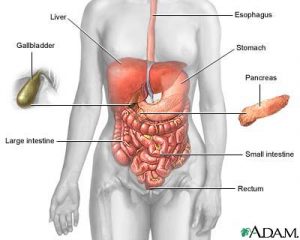Alternate Names : Traveler’s diarrhea – E. coli, Food poisoning – E. coli, E. coli diarrhea, Hamburger disease
Definition
E. coli enteritis is inflammation of the small intestine from Escherichia coli (E. coli) bacteria. It is the most common cause of travelers’ diarrhea.
Overview, Causes, & Risk Factors
E. coli is a type of bacteria that normally lives in the intestines of humans and animals without causing any problems. However, certain types (or strains) of E. coli can cause food poisoning. One strain (E. coli O157:H7) can cause a severe case of food poisoning.
E. coli germs can get into the food you eat (called contamination) in different ways:
- Meat or poultry can come into contact with the normal bacteria from the intestines of an animal while it is being processed
- Water used during growing or shipping can contain manure or human waste
- Unsafe food handling or preparation in grocery stores, restaurants, or homes
Food poisoning can then occur from eating or drinking:
- Any food prepared by someone who did not use proper hand washing techniques
- Any food prepared using cooking utensils, cutting boards, and other tools that were not fully cleaned
- Dairy products or food containing mayonnaise (such as coleslaw or potato salad) that have sat out of the refrigerator too long. This is most likely to occur in cafeterias, on picnics, and during large social functions.
- Frozen or refrigerated foods that are not stored at the proper temperature or are not reheated properly
- Raw fish or oysters
- Raw fruits or vegetables that have not been washed well
- Raw vegetable or fruit juices and dairy (look for the word “pasteurized”)
- Undercooked meats or eggs
- Water from a well or stream, or city or town water that has not been treated
Although not common, E. coli can be spread from one person to another. This may happen when someone does not wash their hands after a bowel movement and then touches other objects or someone else’s hands.
Pictures & Images
Digestive system
 The esophagus, stomach, large and small intestine, aided by the liver, gallbladder and pancreas convert the nutritive components of food into energy and break down the non-nutritive components into waste to be excreted.
The esophagus, stomach, large and small intestine, aided by the liver, gallbladder and pancreas convert the nutritive components of food into energy and break down the non-nutritive components into waste to be excreted.
Digestive system organs

The digestive system organs in the abdominal cavity include the liver, gallbladder, stomach, small intestine and large intestine.
-
E. coli enteritis : Overview, Causes, & Risk Factors
-
E. coli enteritis : Symptoms & Signs, Diagnosis & Tests
-
E. coli enteritis : Treatment



Review Date : 1/20/2010
Reviewed By : Linda J. Vorvick, MD, Medical Director, MEDEX Northwest Division of Physician Assistant Studies, University of Washington, School of Medicine; and George F. Longstreth, MD, Department of Gastroenterology, Kaiser Permanente Medical Care Program, San Diego, California. Also reviewed by David Zieve, MD, MHA, Medical Director, A.D.A.M., Inc.
The information provided herein should not be used during any medical emergency or for the diagnosis or treatment of any medical condition. A licensed medical professional should be consulted for diagnosis and treatment of any and all medical conditions. Call 911 for all medical emergencies. Links to other sites are provided for information only — they do not constitute endorsements of those other sites. © 1997- 2010 A.D.A.M., Inc. Any duplication or distribution of the information contained herein is strictly prohibited.
